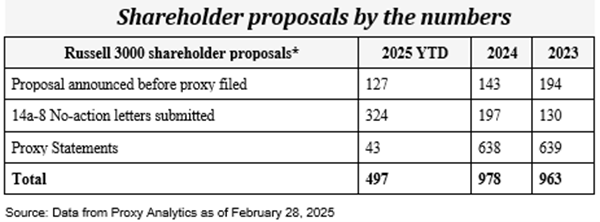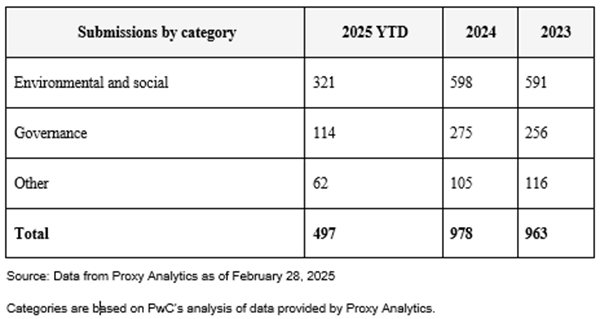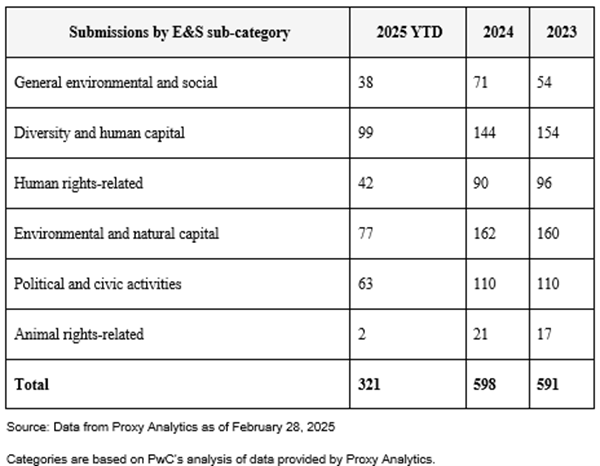|
Editor’s Note:
Ray Garcia is
a Leader, Matt
DiGuiseppe is a Managing Director, and Ariel
Smilowitz is a Director at the PricewaterhouseCoopers
(PwC) Governance Insights Center. This post is based on their PwC
memorandum. |
The flurry of activity coming out of the Trump Administration is
ushering in a new paradigm for investment stewardship of
environmental, social and governance (ESG) considerations. Over the
course of a few weeks in February 2025, the SEC issued significant new
guidance on topics ranging from shareholder proposals to investor
engagement and communication. In some ways, this shift in approach
raises questions about how business priorities and voting outcomes
will be impacted during this year’s proxy season, while in other ways
it may provide additional clarity.
As the market responds in real time, we anticipate that investors’
engagement and proxy voting strategies will evolve to address
potential legal and regulatory risks. We foresee the return of “quiet
diplomacy,” in which investors take less public credit for the impact
of their stewardship activities and surreptitiously articulate their
positions on governance issues related to specific companies. That
said, investors will also seek to understand how boards are overseeing
relevant business risks if company policies, practices or disclosures
are modified. Here, we outline how these developments may unfold,
along with steps boards and management teams can take to successfully
navigate through proxy season.
Companies may experience a shift in investor engagement
As we head into the 2025 proxy season, we expect to see a marked
change in how institutional investors communicate and engage with
portfolio companies. In particular, investors may be less forthcoming
and transparent in discussions with boards and management about their
views on board composition, executive compensation and shareholder
rights, among other issues.
Passive investors confront engagement limitations
One factor that may impact shareholder
engagement is the SEC’s new guidance on
who can be considered a large passive investor versus an active
investor. Before this guidance, large active investors were generally
understood to be those that took a position greater than 5% of a
company’s shares with the intention of influencing its management or
operations, like a hedge fund. However, the SEC expanded its
interpretation of an active investor to include an investor who —
through engagement — uses his or her vote to exert pressure on the
company to change its governance, environmental, social, compensation
or other practices. The new interpretation means that the largest
investors, many of whom follow an index and have sizeable equity
stakes in thousands of companies, will potentially need to change the
way they engage with companies or stop doing so all together to avoid
the cost and complexity associated with the reporting requirements for
active investors.
Proxy voting policies become less prescriptive
Institutional investors are also softening the language they use in
their voting guidelines, particularly about board diversity
expectations. For example, several large investors have updated their
voting guidelines to remove the mention of aspirational board
diversity targets and broaden the definition of diversity beyond
personal or demographic factors. Additionally, proxy advisor
Institutional Shareholder Services (ISS) announced that it has halted
the consideration of diversity factors when making voting
recommendations for directors. Proxy advisor Glass Lewis also
announced it will provide clients with research to help them consider
multiple voting outcomes on board diversity.
What this means for companies
As institutional investors alter their
voting policies and engagement practices, the onus will fall on
companies to have line of sight into investors’ voting intentions.
Investors have never been required to publicly disclose the rationale
underpinning vote decisions, especially as they pertain to individual
directors. And in some cases, there are several factors that come
together, including insights from engagement discussions, that can’t
be easily unwound. Ultimately, companies will need to analyze
investors’ stewardship programs to understand what they are
prioritizing and develop targeted
communications strategies. Part
of that analysis includes proactively identifying where governance
practices do not align with shareholder expectations, so that the
mismatch can be addressed in disclosures or engagement meetings
without the investor raising it via the engagement. Otherwise,
companies might miss out on opportunities to tend to the concerns of
their top shareholders.
Shareholder proposals may fluctuate in quantity, scope and
purpose
We expect shareholder proposals will continue to polarize investors,
resulting in varying levels of support. Even so, we anticipate
investors will focus on assessing proposals through a company-specific
risk lens. Multiple factors are contributing to this trend.
Shareholder proposals face new restrictions
In February, the SEC rescinded prior
guidance on shareholder proposals, making it easier for companies to
exclude proposals that are not economically relevant, seek to
micromanage or are too broad in nature rather than unique to the
company’s circumstances.
Early data shows that the number of SEC no-action requests increased
by 35% year-over-year before the SEC weighed in, indicating that the
SEC’s action was largely anticipated. But the new guidance essentially
places a higher burden on the proponent to demonstrate how the
proposal is material to the company’s business. It remains to be seen
how the SEC will apply this guidance to the no-action requests
reviewed after the change, especially given how rarely the SEC has
relied on the economic impact threshold in past decisions. However,
some companies have already successfully eliminated shareholder
proposals on topics that were permissible in the past, like corporate
political activities.
 |
*Before proxy statements are filed, we can gain preliminary insights
into which proposals may be included on the corporate ballot through
the tracking of 14a-8 no-action requests to the SEC and voluntary
disclosures made by shareholder proponents. Some of the proposals
tracked will be withdrawn based on engagement activities before the
annual meeting. The rest will appear in proxy statements. There are
several shareholders that do not announce where they have filed
proposals ahead of time, so we will not know the final makeup until
after proxy season.
Investors expected to gravitate towards ESG topics that impact company
performance
Last year, investors generally did not use their votes to support
shareholder proposals asking companies to curtail their ESG
activities. In other words, there was no signal from investors that
companies should back off from these efforts. This year, we expect a
rise in both the number of shareholder proposals and proponents asking
companies to reverse course on these topics. However, we do not expect
to see significant changes in how investors vote on these “anti-ESG”
proposals and anticipate they will continue to not support them.
The shareholder proposal “resolved clause” takes center stage
Although proponents with divergent
political views are filing shareholder proposals, investors are
demonstrating that they are more interested in the risks posed by the
topic addressed in each proposal and the ask of the company — the
resolved clause — than the proponent’s public postering on the issue.
One example is the area of artificial intelligence (AI) oversight.
Our recent
survey of US investor priorities
for 2025 affirms that investors representing a range of investment
approaches are rallying around the opportunities presented by AI,
which in turn invites greater scrutiny of companies’ practices. Last
year, technology companies faced a swell of AI-related shareholder
proposals asking for enhanced guardrails and more transparency about
how boards are overseeing risks that may arise when this technology is
deployed. Some of these proposals were filed by proponents across the
political spectrum yet still received significant support from
shareholders. For this year’s proxy season, Glass Lewis also developed
a new approach to assessing AI risk oversight that may result in an
increased number of adverse vote recommendations on directors and
elevation of this topic during engagement meetings.
What this means for companies
Companies may find fewer shareholder
proposals on the proxy statement this year. But when one does appear,
it’s important to understand that the company-specific risks and
actions requested in the shareholder proposal — not the proponent’s
intent, reputation or political views — ultimately drive how investors
will vote. According to our Stewardship
investor survey, the resolved
clause in the shareholder proposal is one of the most important
factors in making a voting decision. On the other hand, the
proponent’s perceived political leaning and public statements are some
of the least important factors. Consequently, a company should focus
on disclosing how it is managing the risks raised by a shareholder
proposal in a manner aligned with value creation rather than simply
arguing against the proponent’s position.
Shareholder activists may consider new strategies to signal
concerns
As SEC reforms spur potential changes to the shareholder engagement
and shareholder proposal landscape, shareholder activists may
increasingly turn to other tactics such as vote “no” campaigns and
proxy contests.
Activists encounter communication-related barriers
That said, the SEC recently introduced new
limitations on how shareholder proponents can use the SEC’s electronic
filing platform to communicate with other shareholders. With this in
mind, activists may look for alternative ways to promote their
messages.
One strategy is using a company’s advance notice bylaws to introduce
shareholder proposals. Under this process, companies cannot exclude
proposals from appearing on the ballot, and shareholders can put forth
as many proposals as they choose without minimum shareholding
requirements. But the notice process is more costly and cumbersome as
companies have different information requirements and submission
deadlines.
Another strategy is harnessing social media and other digital
platforms to reach new audiences. Even traditional hedge fund
activists are broadening their aperture as campaigns surge to greater
levels.
What this means for companies
As shareholder activism continues to
evolve, it is important for companies to understand how activists
pursue their goals so they can prepare and respond accordingly. In
2024, over 70% of board members in our Annual
Corporate Directors Survey said
their boards had taken action in response to shareholder activism,
including engaging a third party to advise the board and tracking
ownership changes. As companies dedicate more time to activist
preparedness, they should consider the potential for new activist
scenarios.
|
Harvard Law School Forum on
Corporate Governance
All copyright and trademarks in
content on this site are owned by their respective owners. Other
content © 2025 The President and Fellows of Harvard College.
Privacy
Policy |




